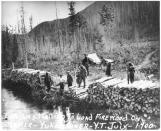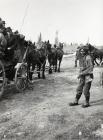1
CONTENTS:- Steamboats and Woodcamps
- Roadhouses on the Overland Trail
2
Steamboats and WoodcampsFrom the early 1900s until 1950, steamboats (also called "sternwheelers" or "riverboats") were a vital link between communities on the Yukon River. Carmacks and Little Salmon Village were two of the popular stops along the Yukon River. The steamboat would transport people and supply trading posts, while people along the way would supply the steamboat with wood or coal for fuel.
During the steamboat era, there were many wood camps throughout the Carmacks area, and this became a new economic opportunity for First Nation people. They supplemented their trapping income by cutting wood for much of the summer. Wood camps were located at Big Salmon, Byers' (also called Erickson's) wood camp, Little Salmon, and Lakeview, among others. Each camp cut 200-300 cords of wood per season (a cord is a stack of wood that measures 4ft x 4ft x 8 ft). Elder Gertie Tom (1987: 23) remembers that "after we cut wood, we got food in exchange. We only worked for food; we didn't ever see any money to speak of. My dad worked really hard to get food for his children".
Some First Nation people would also travel on the steamers and work as deckhands, loading sacks of silver-lead and firewood on the boat. They also handled freight on the docks and cut fuel for the steamer as longshoremen.
Five Finger Rapids, 30 km downstream from Carmacks, was the most dangerous obstacle on the Yukon River for steamboats. The channels were actually widened with explosives, and large winches were installed on shore to guide the huge boats through.
The worst accident of the steamboat era occurred near Ts'äl Cho An (Eagle Rock) in 1906. The steamboat Columbian was carrying three tons of blasting powder for Tantalus Mine. Two deck hands were admiring a rifle when it went off an ignited the powder. Several men died, many more were badly injured, and the ship was abandoned to burn.
The Klondike Highway was constructed in 1950, which brought an end to the steamboat era. Large amounts of supplies could now be easily transported by road in all seasons, so the large, expensive riverboats were no longer needed.
3
First Nation people at wood camp1900
Tagé Cho (Yukon River)
 Credits:
Credits:(Yukon Archives PHO 377 89-59 #29)
5
Sternwheeler Crew fishing for cable, Tthi Cho Nadezhe1926
Tthi Cho Nadezhe (Five Finger Rapids)
 Credits:
Credits:(Yukon Archives PHO 219 83-22 #14)
6
Roadhouses on the Overland TrailSternwheel riverboats were limited to travelling in the summer, and the winter trip from Whitehorse to Dawson by dog team was very difficult.
In 1902, an all-season road called the Overland Trail was built from Whitehorse to Dawson, which followed First Nations foot trails in many places. For every 23 miles of road, there was a roadhouse or rest stop for the stage couch. The Carmacks roadhouse was the sixth stop along the Dawson Trail, and therefore, the roadhouse was known as #6.
A one way fair from Whitehorse to Dawson was $75-100 per person. During the summer the price would cost $125.00 the meals and beds cost extra. The passengers were allowed 25 pounds of free luggage; extra luggage was 30 cents a pound.
The Carmacks roadhouse was built by a couple of early settlers, Seymour Rowlinson and Eugene Mack. The two-storey roadhouse was built at the mouth of Nordenskiold River, with a horse stable nearby. The cost for a meal was $2.50, $1.50 to sleep in the bunkroom and $2.00 for a bed and blanket. The roadhouse consisted of 20 beds and a dining room that would sit 40-50 people.
The Overland Trail and Roadhouse #6 played a major role in Carmacks' future. These facilities attracted many people to the area, which also encouraged other merchants like Tom Bee and Taylor & Drury to set up shop. As more Northern Tutchone people began to settle in the area, Carmacks became a major centre. If the Overland Trail had followed another route, the village of Carmacks might not exist here today.
7
Carmacks Roadhouse and White Pass Yukon Route stables1914
Carmacks, Yukon
 Credits:
Credits:(Yukon Archives PHO 389 90/19-2 # 29)
8
Carmacks man beside passenger stage of White Pass & Yukon RouteDate not available
 Credits:
Credits:(Yukon Archives 59/6)
